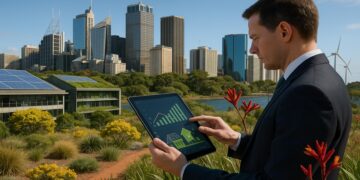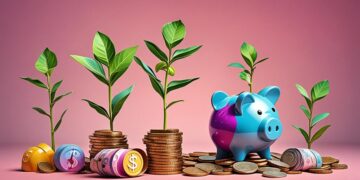Investing in Green Technology: The Future of Sustainable Finance in Australia

The Shift Towards a Sustainable Economy
Australia stands at a crucial juncture where its economic future is intricately tied to the adoption of sustainable practices. The escalating fears surrounding climate change and environmental degradation mean that investing in green technology is no longer just a buzzword; it has become an essential component of economic strategy. As citizens grow increasingly aware of their ecological footprint, the investment landscape is also transforming, with significant implications for both the economy and the environment.
Key Drivers of Change
Several factors are underpinning this shift towards sustainability. Firstly, government initiatives play a pivotal role. Programs and policies designed to promote renewable energy sources like wind and solar are not only encouraging innovation but are also establishing a legislative framework that actively supports clean energy investments. The Australian government has set ambitious targets under its renewable energy roadmap, aiming for 50% of the nation’s electricity to be generated from renewable sources by 2030, thereby providing a robust incentive for businesses to pivot towards cleaner alternatives.
Another significant driver of this movement is innovation. Australia is witnessing a burgeoning scene of tech startups making strides in areas such as electric vehicles, battery technology, and sustainable agricultural practices. For instance, companies developing advanced battery storage solutions are not only addressing energy resilience but also facilitating the wider adoption of solar power, allowing households and businesses alike to harness renewables efficiently. Such innovations serve a dual purpose: they advance technology while concurrently propelling Australia towards its climate goals.
Moreover, there is a palpable shift in public support for sustainable options. Australian consumers are increasingly prioritizing environmentally friendly products, evident in the surging demand for organic foods, eco-friendly packaging, and energy-efficient appliances. This changing consumer sentiment is compelling businesses to adopt greener practices, thereby enhancing their market competitiveness and ensuring they resonate with the values of their customers.
Diverse Applications of Green Technology
Green technology encompasses a wide range of sectors essential to fostering sustainability. Renewable energy sources such as wind, solar, and hydroelectric power are front and center in this journey, dictating the future of how energy is generated and consumed. From the massive solar farms in Queensland to offshore wind projects planned for the southern coast, Australia is strategically positioned as a leader in renewable energy production.
Additionally, energy efficiency technologies are dramatically reshaping how industries operate. Innovations such as smart grids and energy monitoring systems help businesses optimize their power usage, decrease waste, and save costs. This not only reduces carbon emissions but also improves the bottom line, showcasing that sustainability and profitability can go hand-in-hand.
Similarly, waste management advancements are critical in addressing the nation’s growing waste crisis. Technologies that improve recycling rates and reduce landfill reliance—like AI-driven sorting facilities—transform how communities manage waste. These initiatives not only lessen environmental impact but also open new economic avenues in the circular economy.
A Sustainable Future
As investors increasingly recognize that sustainable finance is not merely an altruistic endeavor but also a pathway to long-term profits, the embrace of green technologies is paving the way for a sustainable future in Australia. By integrating ecological considerations into investment strategies, financial leaders are ensuring that they contribute positively to the planet while safeguarding their financial interests. This symbiotic relationship between the economy and the environment underscores the critical importance of transitioning to sustainable practices—dictating not only the well-being of the current generation but also preserving the Earth for future Australians.
Unlocking the Potential of Green Technology
The transition to a sustainable economy is more than just an ecological necessity; it’s a potent economic opportunity. In Australia, the growing recognition of green technology as a cornerstone of sustainable finance is reshaping investment paradigms, presenting numerous avenues for growth. Investors are now called upon not only to consider financial returns but also their impact on the environment. This shift signifies a burgeoning market where profitability and sustainability can coalesce.
The Role of Investment in Driving Change
Investment in green technologies is pivotal for several reasons. Firstly, it addresses the critical problem of climate change, which poses substantial risks to Australia’s economy. From increasing temperatures to severe droughts and bushfires, the adverse effects of climate change amplify the importance of transitioning to renewable energy resources. When investors funnel capital into green tech, they are actively participating in the fight against these pressing issues. This proactive approach not only mitigates risks but also catalyzes innovation in sectors that will define Australia’s economic landscape for decades to come.
Secondly, there is a profound potential for job creation in this emerging sector. According to the Clean Energy Council, the renewable energy industry alone employs over 28,000 people and is expected to create over 27,000 more jobs by 2025. The investment in solar energy, wind farms, and energy-efficient technologies will have far-reaching impacts on regional economies, ensuring that local communities benefit from the green transition. This employment boom is vital, particularly for rural and regional Australia, where traditional industries may be on the decline.
In conjunction with job creation, financial returns are becoming increasingly attractive. Various studies indicate that companies focused on sustainability tend to outperform their traditional counterparts in the long run. Investors are now recognizing that integrating environmental, social, and governance (ESG) criteria into their investment strategies can drive substantial financial benefits. Here are some factors contributing to the allure of green tech investments:
- Government incentives: Subsidies and grants for renewable energy projects can significantly offset initial costs, increasing the attractiveness of investments.
- Technological advancements: Rapid innovations in green technology are enhancing efficiencies and reducing costs, making it more accessible for businesses and consumers alike.
- Consumer demand: The rising trend of environmentally conscious consumers is pushing companies to adopt sustainable practices, directly impacting their profitability.
In relation to the financial sector, institutions are increasingly incorporating sustainable finance into their portfolios. Australian banks are recognizing the shift and are actively seeking to support projects that prioritize environmental sustainability. Initiatives such as green bonds and sustainable investment funds are gaining momentum, allowing investors to fund projects that fulfill sustainability criteria while also reaping financial rewards.
The integration of green technology into the economic framework is not merely beneficial—it is imperative for Australia’s future. The commitment to sustainability positions the nation at the forefront of the global green tech revolution, enabling Australian businesses to innovate, thrive, and create a lasting legacy for future generations.
Building a Sustainable Investment Ecosystem
The momentum towards a green economy in Australia is not a solitary endeavor; it requires a collaborative approach from all stakeholders involved—government, businesses, and the community. Public policy plays a crucial role in shaping the landscape for green technology investments. The Australian government has already introduced policies aimed at reducing carbon emissions, like the Climate Solutions Fund, which incentivizes emission reductions in various sectors. By continuing to enhance regulatory frameworks and providing clear long-term targets, the government can cultivate a favorable environment for sustainable finance.
The Importance of Public-Private Partnerships
Public-private partnerships (PPPs) are pivotal in fostering innovation and accelerating green technology adoption. These collaborations facilitate the exchange of knowledge and resources, thereby reducing financial risks and enhancing project viability. For instance, initiatives like the Renewable Energy Target (RET) have showcased how government backing can mobilize private sector investments to meet renewable energy goals. In this context, local governments can also champion grassroots initiatives, enticing community investors and small businesses to participate actively in green projects that directly benefit their locales.
Coupled with PPPs, the role of impact investing cannot be understated. This investment strategy aims to generate measurable social and environmental impact alongside financial returns. Australians are increasingly drawn to this approach, recognizing the power of their investments to drive positive change. For example, the rise of ethical superannuation funds, which prioritize investments in sustainable enterprises, indicates that there is a growing appetite for responsibly managed financial products among Australian consumers. This trend emphasizes the need for financial institutions to embrace and promote such ethical alternatives, showing that sustainability is not only a moral imperative but also a viable investment strategy.
Moreover, the continuous advancement of technological solutions for energy efficiency exemplifies how innovation can drive sustainable finance. Emerging technologies such as solar battery storage and smart grid systems are transforming energy consumption patterns. By allowing households and businesses to generate and store renewable energy, these technologies improve energy independence and resilience. Investments in these innovations will lead to enhanced energy efficiency and create opportunities for manufacturers and tech companies to capitalize on the sector’s potential.
Additionally, the education and engagement of investors and consumers are paramount for building a sustainable finance ecosystem. As more Australians recognize the significance of sustainability, they are beginning to demand transparency and accountability from the brands they support. This growing consumer awareness represents an opportunity for companies to differentiate themselves in the marketplace by showcasing their commitment to sustainable practices. Initiatives such as the Australian Sustainable Finance Initiative (ASFI) provide frameworks for aligning financial channels with sustainability goals, ensuring that businesses remain accountable for their environmental impact.
The intrinsic link between responsible finance and environmental stewardship is becoming increasingly evident. As more Australian corporations adopt sustainable practices, investors are likely to align their portfolios accordingly, leading to an expansion of the green technology market. The symbiotic relationship between investment and environmental responsibility not only signifies a shift in how finance operates but also shapes the country’s economic future. By investing in green technologies, Australia is not merely adapting to change; it is paving the way for an innovative and sustainable financial landscape that will benefit generations to come.
Charting a Course for a Sustainable Future
The journey towards a sustainable economic future in Australia is not just a fleeting trend; it’s an evolving narrative fueled by a collective commitment to green technology and responsible finance. As we navigate this landscape, it becomes increasingly clear that investing in green technology is fundamental to addressing climate change while simultaneously fostering economic growth. The enthusiasm from both the government and private sectors to support initiatives like the Climate Solutions Fund and Renewable Energy Target highlights a shared vision for reducing carbon emissions and promoting renewable resources.
The rise of ethical investing reflects a cultural shift among Australian consumers who now prioritize environmental stewardship alongside financial gains. This shift presents a unique opportunity for financial institutions to innovate and develop products that resonate with the growing demand for sustainability. Furthermore, the emergence of new technologies in energy efficiency, such as solar battery storage and smart grids, underscores the transformative potential of green investments—not only in enhancing energy independence but also in stimulating job creation across sectors.
As we look forward, the role of public-private partnerships and community engagement will be paramount in realizing the full potential of a green economy. By fostering collaboration across all levels of society, Australia can build an investment ecosystem rooted in sustainability that benefits not just the present but also the generations to come. Ultimately, the pathway to a sustainable future is paved with responsible financial decisions, innovative technologies, and a united commitment to nurturing the environment. Investing in green technology is not just a financial strategy; it is an investment in the prosperity and resilience of Australia’s future.

James Carter is a financial writer and advisor with expertise in economics, personal finance, and investment strategies. With years of experience helping individuals and businesses make complex financial decisions, James offers practical insight and analysis. His goal is to give readers the knowledge they need to achieve financial success.






